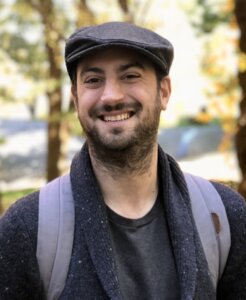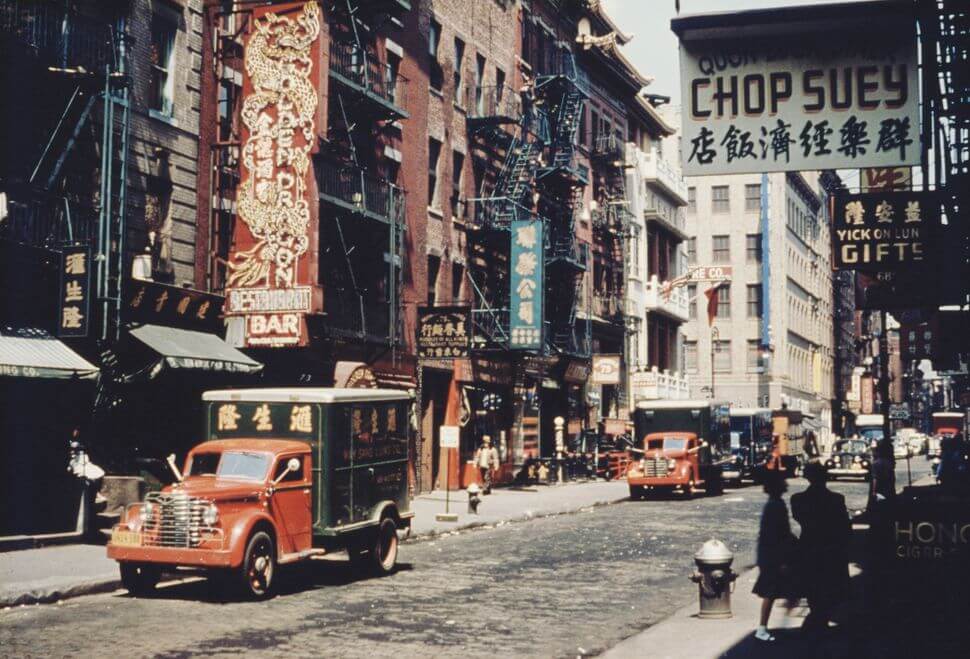I have seen the future of America — in a pastrami sandwich in Queens
San Wei, which serves pastrami sandwiches along with churros and biang biang noodles, represents an immigrant’s fulfillment of the American dream
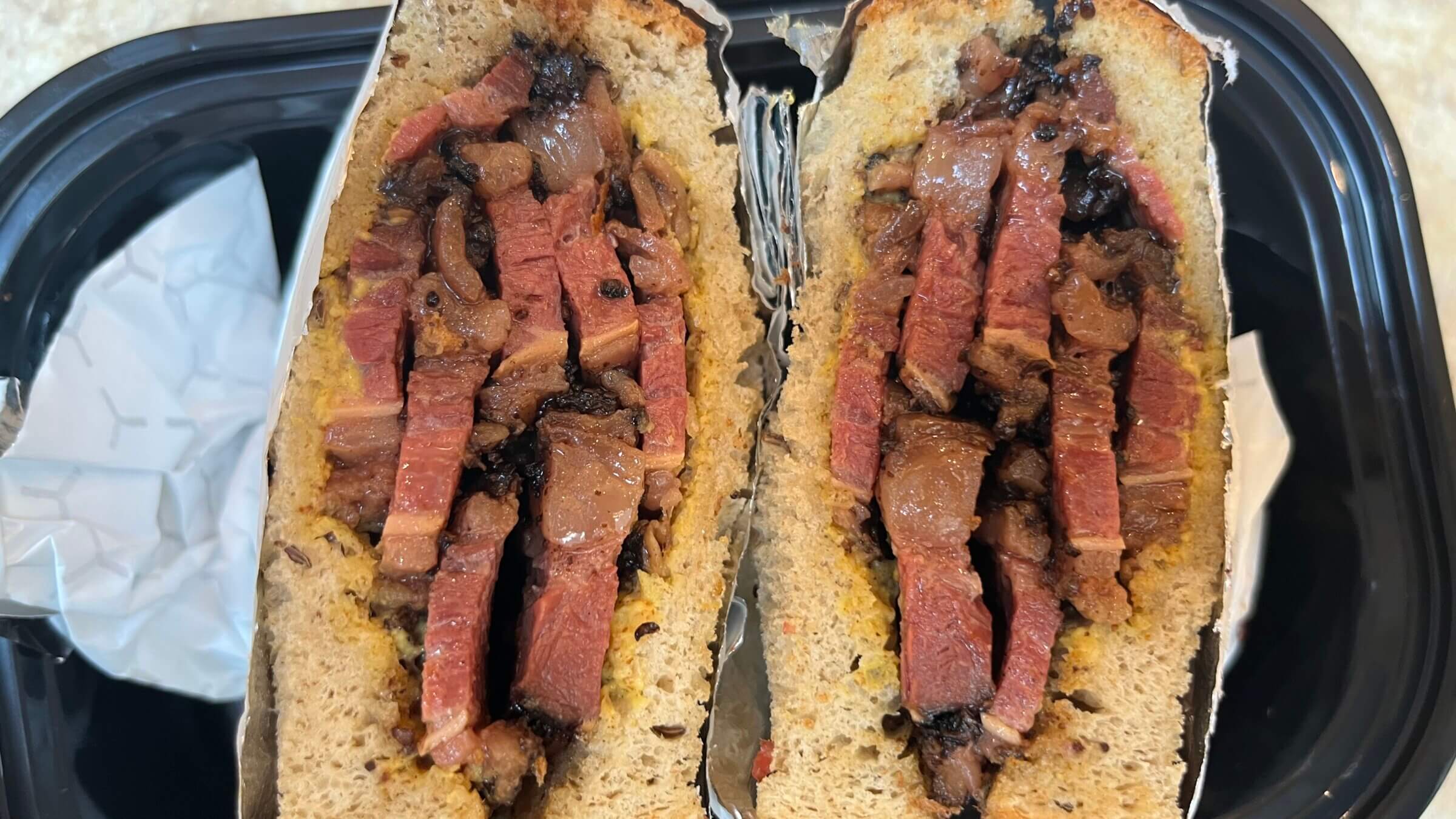
According to the owner of San Wei, its pastrami is second only to Katz’s. Photo by Andrew Silverstein
It’s a ritual.
The counterman sliced the pastrami, piled it between rye and slathered it with mustard. And then he offered sliced pickles. He then prepared my side — in this case, not matzo ball soup, not a crispy latke, but Shanghai scallion oil noodles. This wasn’t Katz’s or Langer’s Deli — it was San Wei, a newly opened hand-pulled noodle stall next to a Chick-fil-A in the Queens Center Mall food court.
And this was not some fusion Kung Pao pastrami. San Wei does serve up the smoked and cured beef on a bao and in a rice bowl, but this was the classic deli sandwich, the one they advertise as “Best Pastrami in Town” on their menu between the “Dumplings” and Hong Kong-style “Coca-Cola Chicken Rice Bowl.”
The sandwich is good, and they’re betting big on it. San Wei is set to open locations soon in Grand Central Terminal, and at the Green Acres mall in Valley Stream, Long Island. And that’s just the start.
A new pastrami concept
I learned about San Wei a few weeks ago from a Facebook post by Jeffrey Orlick, who founded the popular Jackson Heights Momo Crawl in 2012. Orlick is a reliable source for unique, obscure and exceptionally tasty dishes found in Queens backrooms and underground dives. The nation’s most diverse county, Queens is an incubator for ethnic food trends. Besides the momo, Queens has made birria tacos, arepas, and several regional Chinese dishes part of the modern American food vernacular.
Take Xi’an Famous Foods, which started out in a gritty basement stall at the Golden Mall serving recent immigrants in Chinatown Flushing. Then in 2007, Anthony Bourdain feasted on their noodles and a spicy cumin lamb burger on his show No Reservations. Now, it has 16 restaurants across New York.

San Wei is located in the immigrant-dense neighborhood of Elmhurst, but the Queens Center Mall with its atriums, JC Penney and Aunt Annie’s is not some deep insider spot.
And while the owner of San Wei is also from Xi’an in Northern China, he is not a scrappy immigrant cooking up family recipes for his homesick compatriots.
“If I tell you my name,” the owner told me when I found him at the stall on a recent weekday morning, “the story will be about me.”
A business registration showed the San Wei owner to be Shang Dai, the founder of Kuanfu Properties, which in 2015 was described by the real estate publication The Real Deal as a major conduit for Chinese investors in Manhattan condo developments. Dai, who once did hundreds of millions of dollars in property deals, was now working behind the counter in a Queens food court. This, I guess, would be juicy news in the New York real estate world, but I was working the pastrami beat.
San Wei is not the first restaurant launched by Dai, a lawyer who plays in professional poker tournaments. He was one of the investors behind the 400-seat New York location of Dadong, a flashy Beijing Michelin-starred restaurant that closed after two years. “Now,” he told me, ”I’m really focused on this chain concept.”
Last year, the developer — who agreed by email to let me use his name — opened Chomp Chomp in the Connecticut shopping center Danbury Fair, seeing an opportunity after a McDonald’s closed. There, he specializes in smashed burgers, rice bowls, and, of course, pastrami. The more Asian-focused San Wei, however, is the brand he wishes to grow.
“For the mall,” Dai told me, “all the customers deserve not only better food, but more diverse food.” By partnering with the Macerich Company, which owns both the Danbury Fair and the Queens Center Mall, he plans to expand to other shopping centers in their portfolio — which number over 50.
“San Wei’s mission,” Dai added in an email, “is to promote Chinese history and culture.” But he also doesn’t want the restaurant, which has ramen and churros in addition to pastrami on its menu — to be pigeonholed as Chinese. “We want to pick anything that is good from any culture,” he told me, adding that even the Chinese dishes are varied, with biang biang noodles from his native Xi’an and extra spicy noodles in the style of the Chongqing region.
A story that started on the Lower East Side
This multicultural mix is not unlike the deli itself. According to Ted Merwin’s definitive book, Pastrami on Rye, the first delicatessens opened by German immigrants in the 1840s on the Lower East Side sold imported high-end groceries and charcuterie, and made fresh sausages. By the end of the 19th century, Eastern European Jews turned delis into sit-down restaurants, keeping the German beef salami and adding pan-Ashkenazi cuisine with American influences like overstuffed sandwiches of pastrami, which itself evolved from Romanian goose pastrama shaped by its own spice route influences. Shmulka Bernstein on Essex Street took things a step further when, in 1957, the deli added a Chinese food menu.
Fast casual chains, mall food courts, and real estate developers are all things I generally try to avoid. But I found myself excited about San Wei and charmed by Dai’s passion for pastrami. He’s partial to 2nd Ave Deli and Katz’s. “I worked in Manhattan,” he told me, “and made many Jewish friends who took me to all the pastrami places.”
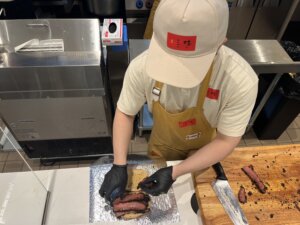
San Wei offers real food and is well-priced. The pastrami sandwich is the most expensive menu item by far, and at $18.95 for a half-pound of meat, it’s not a bad deal. One day, I’ll be in an airport and will be grateful to have the option of San Wei’s dan dan noodles, which could do a Pepsi challenge with my go-to Szechuan spot. But could their thick-cut pastrami go toe-to-toe with my and Dai’s favorites?
“It’s as good as what they serve at the Mets’ stadium,” is how New York magazine’s Grub Street rated the well-rubbed, but a bit fatty, meat, lamenting that San Wei doesn’t “actually make it from scratch,” instead relying on “a third party.” But that’s almost always been the case for delis.
To brine, rub, and smoke beef to pastrami perfection takes weeks and space. Katz’s is rare in that they cure their own meat, doing so in a New Jersey facility. Most places purchase prepared pastrami, then add their own touch as they boil or steam it before serving.
“I can only tell you we tried many places before deciding on this supplier,” Dai told me. An employee, however, let it slip that they get the cured meat in Hunts Point, which happens to be home to Desola Provisions, a provider of pastrami to classic delis — like Hobby’s in Newark and the old Stage Deli — that food writers drool over.
But a deli sandwich is not just meat and rye alone. Tasted blindfolded or in a mall food court, a Katz’s pastrami sandwich is not the same. Indeed, the century-old deli’s outpost in the DeKalb Market Hall, a glorified Brooklyn food court, barely has a line.
A way to be American
Delis are a Jewish experience that connects us to our Garment District forebears. A century ago, the deli became a critical Jewish social space outside of homes, offices or the synagogue — like a town square, or even a mall food court. Delis may feel nostalgic, but for an Ellis Island Jew, just eating out in a restaurant, where women and men rubbed shoulders, was part of becoming an American.
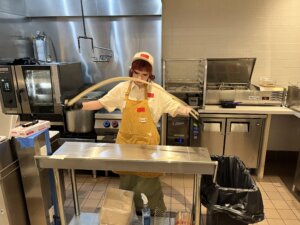
The pastrami sandwich best embodied this newly formed Jewish American identity. Its flavor profile is distinctly Eastern European, while the skyscraper stack of meat speaks to a New World abundance that has come to define our country (albeit at growing ecological cost).
Dai gets it. “Our pastrami is the second best to Katz’s,” he told me proudly. But if Katz’s is a museum of pastrami, San Wei is a laboratory. Chinese customers come for a taste of home, but may end up having their first bite of pastrami. “This is a diverse place,” Dai said, referring to the Queens Center Mall. “People are open to trying new things.”
Often, the new thing they are trying is an American identity. Even as a non-immigrant, I can relate. The Queens Center Mall is one of the most suburban experiences a New Yorker can have by subway. Growing up in New York in the 1990s, visiting a mall with its Muzak, Spencer’s gifts, and Mrs. Field’s cookies offered a rare look into the America I saw on TV. Shopping centers have declined in popularity, but Queens Center Mall chugs on.
Since the mall opened in 1974, the Archie Bunker detached homes of Elmhurst and Corona have become subdivided and over-crowded with East Asian and Latin American arrivals. More than 85% of households in Elmhurst speak another language at home, according to the Census Bureau. The cliques of teens roaming the mall, however, prefer loud Queens-accented English. Young immigrant couples pushing strollers past the mall’s Cheesecake Factory get a whiff of a now-passé version of the American Dream.
And as always, as new immigrants adopt American consumer culture, they change it. With its Colombian jeans and underwear shop competing with Aeropostale and a Burmese Bites alongside a Chipotle, the Queens Center Mall is a transitional cultural space — with the food court and San Wei at its core.
On my first visit, the manager Nick Ai explained that San Wei means “the number three,” which is considered lucky in China and is associated with growth. “It is three flavors: Chinese flavor, Japanese flavor,” the Shanghai native said, “and the pastrami is American.”
I’m fine with eating pastrami without the nostalgia and knishes. Texas barbecue or pastrami fried rice can be very good; they just fall in a different category. San Wei, however, is serving a very Jewish sandwich — and as I sat in the Queens Center Mall, it felt right.
